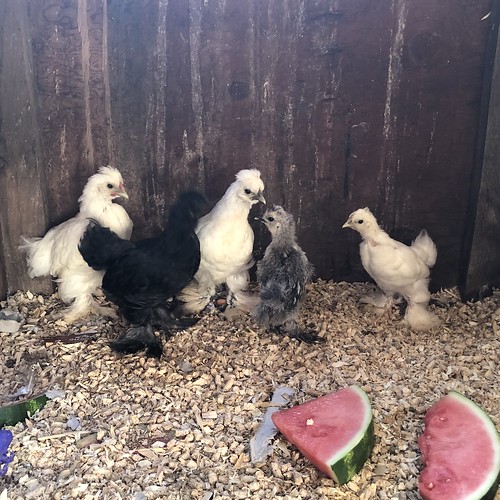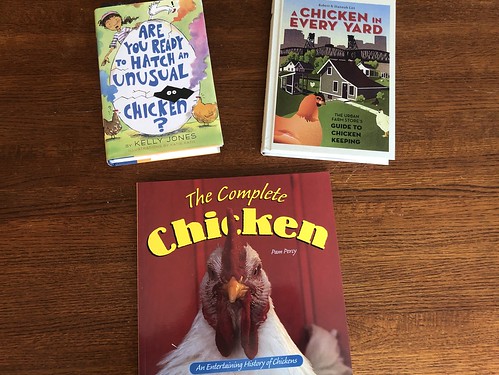Thursday, Thursday, Picture Books! — “Five Minutes (That’s a lot of time) (No, it’s not) (Yes, it is),” by Liz Garton, Audrey Vernick & Olivier Tallec; “16 Words: William Carlos Williams & ‘The Red Wheelbarrow,'”; and “My Tiny Pet,” by Jessie Hartland
(“White Chickens/Black/and Red” photo by Nancy Row Rawley)
I love this picture book’s title, y’all. “Five Minutes (That’s a lot of time) (No, it’s not) (Yes, it is),” written by Liz Garton Scanlon and Audrey Vernick, illustrated by Olivier Tallec (G.P. Putnam’s Sons BFYR, 2019, ages 3-7, $16.99).
This cheerful, goofy picture book takes just about five minutes to read, but you’ll probably end up need 20-25 minutes, total, because the kids will want you to read it four or five times. Five minutes is forever — or it’s not enough, depending on how a person looks at it. Visiting the puppies, bunnies and birds at the pet store? Five minutes is not enough. Just a little more sleep? Please, please more than five minutes. Waiting in line, anywhere? Five minutes takes an eternity. Clever story, sweet illustrations.
Visit the crew — Liz Garton on Twitter @LGartonScanlong, Audrey Vernick and Olivier Tallec.
I have many favorite poems, but this one is in the top five:
“so much depends
upon
a red wheel
barrow
glazed with rain
water
beside the white chickens.”
— William Carlos Williams
What is it about this poem? English majors and their professors, writers and poets, fans of chickens… we all worship it, analyze it, interpret it in different ways. It’s cool to see the poem dissected — and illustrated — in a new picture book, “16 Words: William Carlos Williams & ‘The Red Wheelbarrow,'” (Schwartz & Wade Books, by Lisa Rogers, illustrated by Chuck Groenink, 2019, ages 4-8, 40 pages, $17.99).
I love when this poem is used as a writing prompt; it frees us. It is simple, beautiful, deep, and everything a poem needs to be. Williams was a family doctor in Rutherford, New Jersey. Thaddeus Marshall, a neighbor, was one of his patients. His garden, his wheelbarrow, and the sale of his vegetables inspired Williams, who wrote in his spare time. Who knew? (English majors. Their profs. Writers and poets. #bigsmile)
The illustrations and the words wrap around the poem to give us a nice biography of Mr. Williams, and a beautiful tribute to Mr. Marshall. Enjoy.
For more about the author and illustrator, check Lisa Rogers and Chuck Groenink.
Next up, one just for you, science geeks and art lovers: Jessie Hartland’s “My Tiny Pet,” (Nancy Paulsen Books, 2019, ages 4-8, $17.99). They can survive radiation, the vacuum of space, or live at the bottom of the ocean. They can hibernate for centuries. Their biggest predator, though? You’ll never believe it. Snails.
What is this mysterious creature we’re talking about? Tardigrades! (Aka, “water bears.”) And now someone, believe it or not, has written and illustrated a beautiful, sweet, educational picture book about them. Hartland’s work (gouache) has been compared to Maira Kalman’s (one of the best artists, ever, in the history of the universe, people!) and yes. It does remind me of Kalman’s work.
A little girl and her family are downsizing and moving to the forest, and their pets are all rehomed. But she would really, pretty please, like one small pet? So much love for this book.












